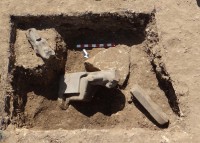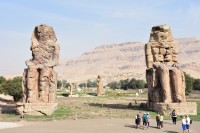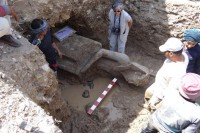 An international team of archaeologists has unearthed 66 statues of the lion-headed goddess Sekhmet in Pharaoh Amenhotep III’s funerary temple complex in Luxor.
An international team of archaeologists has unearthed 66 statues of the lion-headed goddess Sekhmet in Pharaoh Amenhotep III’s funerary temple complex in Luxor.
The discoveries were made during excavations by the German mission in the area between the courtyard and the hall of columns in the temple. The excavation was originally made to search for the remains of the wall separating the two sites.
Some of the discovered statues represent goddess Sekhmet in a seated position, others depict her while standing and holding in her hand the symbol of life and a scepter of the papyrus flower, said mission head Professor Horig Suruzaan.
She pointed out that all the discovered statues are made of Diorite rock.
Built on the west bank of the Nile in ancient Thebes, the funerary temple of Amenhotep III has been brutally ravaged by forces natural and human. Amenhotep III (1386-1349 B.C.) was an ambitious builder and his hometown of Thebes was the recipient of his most ambitious project: a temple complex so massive, it would dwarf the great temples of Karnak and Luxor on the east bank of the Nile. From front to back, it was seven football fields long and covered 350,000 square meters (3,767,000 square feet). For reference, Vatican City is 441,107 square meters.
 All that remains above ground of the great halls, colonnades, courtyards filled with hundreds of statues are the Colossi of Memnon, the two colossal statues of Amenhotep III that flanked the entrance to the temple. An earthquake a century after it was built was the first to inflict major damage. More earthquakes, big ones in the 8th century B.C. and 27 B.C., and Nile floods did worse. Once the blocks started tumbling down, the looting of building materials followed. For centuries subsequent pharaohs treated the crumbling temple like a quarry. “The House of Millions of Years,” as the temple was known in Amenhotep’s time, was little but sugar cane fields and sand 3,400 years later.
All that remains above ground of the great halls, colonnades, courtyards filled with hundreds of statues are the Colossi of Memnon, the two colossal statues of Amenhotep III that flanked the entrance to the temple. An earthquake a century after it was built was the first to inflict major damage. More earthquakes, big ones in the 8th century B.C. and 27 B.C., and Nile floods did worse. Once the blocks started tumbling down, the looting of building materials followed. For centuries subsequent pharaohs treated the crumbling temple like a quarry. “The House of Millions of Years,” as the temple was known in Amenhotep’s time, was little but sugar cane fields and sand 3,400 years later.
Armenian archaeologist Hourig Sourouzian has working to conserve and explore the site since 1998, leading increasingly complex and well-funded excavations of an area that was long believed to be of limited archaeological interest. She suspected there was more of the great temple to be found underground, and boy was she right. The site is incredibly rich in archaeological material underneath a thin surface of desert and sugar cane. Impressive finds like dozens of statues of deities, sacred animals carved in alabaster, the pharaoh and his wife Queen Tiye, a beautifully carved colossal head and a 42 foot-tall colossus of Amenhotep III.
 Statues of Sekhmet, fierce goddess of war and healing, are by far the most numerous. So many have been found (about 150 by my count, including the 66 just announced) that archaeologists think that Amenhotep III may have erected them as offerings to invoke the goddess’ healing powers towards the end of life when he was ill, possibly with arthritis. The team also discovered another statue, a finely carved and polished black granite statue of Amenhotep III as a young man.
Statues of Sekhmet, fierce goddess of war and healing, are by far the most numerous. So many have been found (about 150 by my count, including the 66 just announced) that archaeologists think that Amenhotep III may have erected them as offerings to invoke the goddess’ healing powers towards the end of life when he was ill, possibly with arthritis. The team also discovered another statue, a finely carved and polished black granite statue of Amenhotep III as a young man.
All of the statues are of great artistic and historical value and will be conserved as part of the Colossi of Memnon and Amenhotep III Temple Conservation Project which aims to rebuild some of the temple’s structures and statuary above ground to convey in some small measure the lost grandeur of a temple that, even in utter ruin, still drew crowds of tourists as late as the Roman era.